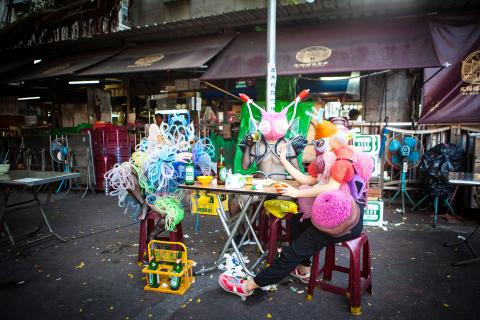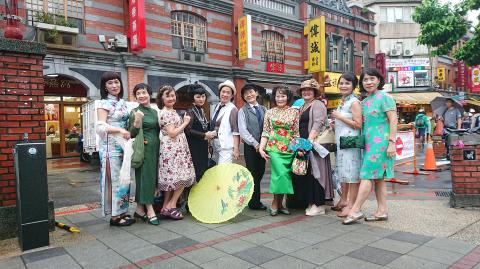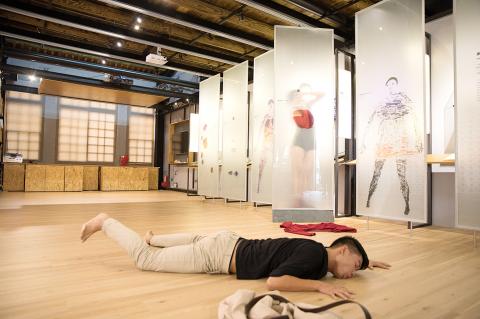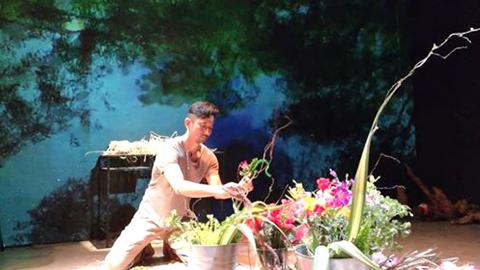October has long been one of the busiest months of the year for Taiwan’s arts scene, but this year it is jammed packed, which means careful planning is needed to keep track of what is going on where and when.
There is the Tua-Tiu-Tiann International Festival of Arts, with workshops, lectures and performances at various locations around Taipei’s historic Dadaocheng (大稻埕) area; the Kuandu Arts Festival (關渡藝術節邁), the annual October celebration of the performing arts hosted by the Taipei National University of the Arts (see story on page 14); the National Theater Concert Hall’s International Theatre Festival, which stretches through the beginning of December, Fall for Great Souls at the National Taichung Theater, Nuit Blanche on Saturday next week and going into the early hours of Sunday, not to mention the opening of the National Kaohsung Center for the Arts Weiwuying, which opens on Oct. 13 and has a terrific first season of shows planned through the end of the year.
It is exhausting just to think about it, never mind trying to budget time and money to see some of the shows and events.

Photo courtesy of the Tua-Tiu-Tiann International Festival of Arts
However, two of the great things about the Tua-Tiu-Tiann International Festival of Arts (TTTIFA, 大稻埕國際藝術節), now in its fourth year, are that a lot of the action is free and audience participation is encouraged at several of the events. The organizers are also collaborating with the Nuit Blanche team, with several events set for next weekend that will expand beyond the Dadaocheng area toward Linsen N Road.
TTTIFA is often described as a time-traveling event, linking Taipei of today with the city in the “roaring 1920s,” when Dadaocheng was a center of Japanese and other foreign businesses and Taipei’s entertainment industry.
It is an independently run festival, organized and sponsored by business, organizations and people in the Dadaocheng area, and their aim to serve as a platform for innovative performances and an opportunity for Taiwanese and foreign artists to collaborate.

Photo courtesy of the Tua-Tiu-Tiann International Festival of Arts
The 12 programs that are part of the festival’s residency program will highlight the work of artists and groups from Taiwan, Thailand, Japan, Macau and Romania, and many are centered on the history of Dadaocheng and the people who lived and worked there decades ago.
These include That Old Feeling in Dadaocheng (舊情野綿綿), which will be performed on Oct. 27 and Oct. 28 at the Little Courtyard Theater, by Slash Youth With 3 Cats (斜槓青年創作體—達利武藏豬五花), a Tainan-based group that includes a student, a Pizza Hut delivery person and theater instructor.
The show is about women who lived and worked in the area decades ago, using old photographs, sounds and stories.

Photo courtesy of the Tua-Tiu-Tiann International Festival of Arts
Romanian Daniel Nicolae Djamo has created 16 Sounds of Dadaocheng, a workshop and a performance piece, and aims to create an audio archive of a future year based on stories by young people about past and future conflicts.
Our Body (回身) by the Inside Out Dance Theatre (反面穿舞蹈劇場), which begins on Oct. 12 and runs through Oct. 21, is about the experiences of the “comfort women” during World War II. Appropriately, it will be performed at the AMA Museum (阿嬤家-和平與女性人權館), which is dedicated to the comfort women of Taiwan.
Sculptor and designer Leeroy New from the Philippines has returned to Taipei and TTTIFA for a second year. His Aliens of Dadaocheng project is a continuation of a work he began during last year’s artist-in-residence program, as well as a take-off from his @aliensofmanila series.

Photo courtesy of Thong Lor Art Space
New’s works encompass film, theater, production design, performing arts and fashion. This year he has been working with students from Taiping Elementary School and others to create larger-than-life puppet costumes inspired by denizens of Taoist temple parades.
The costumes will be featured during Nuit Blanche and at the end of the annual Time Machine Theater-1920s costume parade on Oct. 14.
One of the more unusual match-ups is Bloom / Wilt / Beauty by Nikorn Sae-Tang of Thailand and Takashi Okito from Japan. The 70-minute piece is described as a meditative progress and tale about the nature of life through the contrasting flow of growing and dying, or more simply, a mix of floral creations and performance. It will be held from Oct. 11 to Oct. 14 at the Chunchun Movie & Music Cafe.
While many festival events are free, some of the workshops require advance registration and some performances require tickets, with prices ranging from NT$450 to NT$700 and up, available at NTCH box offices, online at www.artsticket.com.tw or at convenience store ticket kiosks.
There is a dedicated page on the artsticket site for just TTTIFA programs (www.artsticket.com.tw/CKSCC2005/Product/Product00/ProductsCategoriesPage.aspx?ProductsCategoryId=m40sIX3ugy4hM%2BHn9VqGDg).
The festival has an easy to navigate Web site in Chinese and English, covering all the featured programs, open-air events and lectures (www.tttifa.com). A map of the festival sites can be found at www.tttifa.com/en/info.html.

Wooden houses wedged between concrete, crumbling brick facades with roofs gaping to the sky, and tiled art deco buildings down narrow alleyways: Taichung Central District’s (中區) aging architecture reveals both the allure and reality of the old downtown. From Indigenous settlement to capital under Qing Dynasty rule through to Japanese colonization, Taichung’s Central District holds a long and layered history. The bygone beauty of its streets once earned it the nickname “Little Kyoto.” Since the late eighties, however, the shifting of economic and government centers westward signaled a gradual decline in the area’s evolving fortunes. With the regeneration of the once

Even by the standards of Ukraine’s International Legion, which comprises volunteers from over 55 countries, Han has an unusual backstory. Born in Taichung, he grew up in Costa Rica — then one of Taiwan’s diplomatic allies — where a relative worked for the embassy. After attending an American international high school in San Jose, Costa Rica’s capital, Han — who prefers to use only his given name for OPSEC (operations security) reasons — moved to the US in his teens. He attended Penn State University before returning to Taiwan to work in the semiconductor industry in Kaohsiung, where he

On May 2, Chinese Nationalist Party (KMT) Chairman Eric Chu (朱立倫), at a meeting in support of Taipei city councilors at party headquarters, compared President William Lai (賴清德) to Hitler. Chu claimed that unlike any other democracy worldwide in history, no other leader was rooting out opposing parties like Lai and the Democratic Progressive Party (DPP). That his statements are wildly inaccurate was not the point. It was a rallying cry, not a history lesson. This was intentional to provoke the international diplomatic community into a response, which was promptly provided. Both the German and Israeli offices issued statements on Facebook

Perched on Thailand’s border with Myanmar, Arunothai is a dusty crossroads town, a nowheresville that could be the setting of some Southeast Asian spaghetti Western. Its main street is the final, dead-end section of the two-lane highway from Chiang Mai, Thailand’s second largest city 120kms south, and the heart of the kingdom’s mountainous north. At the town boundary, a Chinese-style arch capped with dragons also bears Thai script declaring fealty to Bangkok’s royal family: “Long live the King!” Further on, Chinese lanterns line the main street, and on the hillsides, courtyard homes sit among warrens of narrow, winding alleyways and